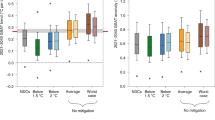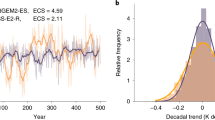Abstract
The world's governments agreed to limit global mean temperature change to below 2 °C compared with pre-industrial levels in the years following the 2009 climate conference in Copenhagen. This 2 °C warming target is perceived by the public as a universally accepted goal, identified by scientists as a safe limit that avoids dangerous climate change. This perception is incorrect: no scientific assessment has clearly justified or defended the 2 °C target as a safe level of warming, and indeed, this is not a problem that science alone can address. We argue that global temperature is the best climate target quantity, but it is unclear what level can be considered safe. The 2 °C target is useful for anchoring discussions, but has been ineffective in triggering the required emission reductions; debates on considering a lower target are strongly at odds with the current real-world level of action. These debates are moot, however, as the decisions that need to be taken now to limit warming to 1.5 or 2 °C are very similar. We need to agree how to start, not where to end mitigation.
This is a preview of subscription content, access via your institution
Access options
Subscribe to this journal
Receive 12 print issues and online access
$259.00 per year
only $21.58 per issue
Buy this article
- Purchase on Springer Link
- Instant access to full article PDF
Prices may be subject to local taxes which are calculated during checkout




Similar content being viewed by others
References
The Cancun Agreements: Outcome of the Work of the Ad Hoc Working Group on Long-term Cooperative Action Under the Convention FCCC/CP/2010/7/Add.1 Decision 1/CP.16 (UNFCCC, 2010).
Rogelj, J. et al. Energy system transformations for limiting end-of-century warming to below 1.5 °C. Nature Clim. Change 5, 519–527 (2015).
Geden, O. & Beck, S. Renegotiating the global climate stabilization target. Nature Clim. Change 4, 747–748 (2014).
Victor, D.G. & Kennel, C.F. Climate policy: ditch the 2° C warming goal. Nature 514, 30 (2014).
United Nations Framework Convention on Climate Change (UN, 1992)..
Report of the Conference of the Parties on its Eighteenth Session, Held in Doha from 26 November to 8 December 2012 - Addendum - Part Two: Action Taken by the Conference of the Parties at its Eighteenth Session FCCC/CP/2012/8/Add.1 (UNFCCC, 2012)..
Stirling, A. Keep it complex. Nature 468, 1029–1031 (2010).
Schmidt, G.A. What should climate scientists advocate for? Bull. Atom Sci. 71, 70–74 (2015).
Steinacher, M., Joos, F. & Stocker, T.F. Allowable carbon emissions lowered by multiple climate targets. Nature 499, 197–201 (2013).
Leemans, R. & Eickhout, B. Another reason for concern: regional and global impacts on ecosystems for different levels of climate change. Glob. Environ. Change 14, 219–228 (2004).
LoPresti, A. et al. Rate and velocity of climate change caused by cumulative carbon emissions. Environ. Res. Lett. 10, 095001 (2015).
Deser, C., Knutti, R., Solomon, S. & Phillips, A.S. Communication of the role of natural variability in future North American climate. Nature Clim. Change 2, 775–779 (2012).
IPCC. Climate Change 2013: The Physical Science Basis (eds Stocker, T. F. et al.) (Cambridge Univ. Press, 2013).
Tebaldi, C. & Arblaster, J. Pattern scaling: its strengths and limitations, and an update on the latest model simulations. Climatic Change 122, 459–471 (2014).
Herger, N., Sanderson, B.M. & Knutti,, R. Improved pattern scaling approaches for the use in climate impact studies. Geophys. Res. Lett. 42, 3486–3494 (2015).
Fischer, E.M. & Knutti, R. Anthropogenic contribution to global occurrence of heavy-precipitation and high-temperature extremes. Nature Clim. Change 5, 560–564 (2015).
IPCC. Climate Change 2014: Impacts, Adaptation, and Vulnerability. Part A: Global and Sectoral Aspects (eds Field, C. B. et al.) (Cambridge Univ. Press, 2014).
Mahlstein, I. & Knutti, R. September Arctic sea ice predicted to disappear near 2 °C global warming above present. J. Geophys. Res. 117, D06104 (2012).
Nordhaus, W.D. A Question of Balance: Economic Modelling of Global Warming (Yale Univ. Press, 2008).
Rockstrom, J. et al. A safe operating space for humanity. Nature 461, 472–475 (2009).
Steffen, W. et al. Planetary boundaries: guiding human development on a changing planet. Science 347, 1259855 (2015).
Knutti, R. & Sedláček, J. Robustness and uncertaintiesin the new CMIP5 climate model projections. Nature Clim. Change 3, 369–373 (2013).
Fischer, E.M., Sedláček, J., Hawkins, E. & Knutti, R. Models agree on forced response pattern of precipitation and temperature extremes. Geophys. Res. Lett. 41, 8554–8562 (2014).
Sedláček, J. & Knutti, R. Half of the world's population experience robust changes in the water cycle for a 2°C warmer world. Environ. Res. Lett. 9, 044008 (2014).
Tschackert, P. 1.5°C or 2°C: a conduit's view from the science-policy interface at COP20 in Lima, Peru. Clim. Change Resp. 2, 1–11 (2015).
Knutti, R. & Hegerl, G.C. The equilibrium sensitivity of the Earth's temperature to radiation changes. Nature Geosci. 1, 735–743 (2008).
Hansen, J., Sato, M., Russell, G. & Kharecha, P. Climate sensitivity, sea level and atmospheric carbon dioxide. Phil. Trans. R. Soc. A 371, 20120294 (2013).
Solomon, S., Plattner, G., Knutti, R. & Friedlingstein, P. Irreversible climate change due to carbon dioxide emissions. Proc. Natl Acad. Sci. USA 106, 1704–1709 (2009).
Bouttes, N., Gregory, J.M. & Lowe, J.A. The reversibility of sea level rise. J. Clim. 26, 2502–2513 (2013).
Davis, S., Caldeira, K. & Matthews, H. Future CO2 emissions and climate change from existing energy infrastructure. Science 329, 1330–1333 (2010).
Matthews, H.D. & Solomon, S. Irreversible does not mean unavoidable. Science 340, 438–439 (2013).
Ricke, K.L. & Caldeira, K. Maximum warming occurs about one decade after a carbon dioxide emission. Environ. Res. Lett. 9, 124002 (2014).
MacDougall, A.H, Avis, C.A. & Weaver, A.J. Significant contribution to climate warming from the permafrost carbon feedback. Nature Geosci. 5, 719–721 (2012).
Erickson, P., Kartha, S., Lazarus, M. & Tempest, K. Assessing carbon lock-in. Environ. Res. Lett. 10, 084023 (2015).
Baer, P. in Climate Change Policy: A Survey (eds Schneider, S. H., Rosencranz, A. & Niles, J.O.) Ch. 19, 393–408 (Island Press, 2002).
Knutti, R. & Rogelj, J. The legacy of our CO2 emissions: a clash of scientific facts, politics and ethics. Climatic Change http://doi.org/896 (2015).
Raupach, M.R. et al. Sharing a quota on cumulative carbon emissions. Nature Clim. Change 4, 873–879 (2014).
Nordhaus, W.D. Economic growth and climate: the carbon dioxide problem. Am. Econ. Rev. 67, 341–346 (1977).
Siegenthaler, U. & Oeschger, H. Predicting future atmospheric carbon dioxide levels. Science 199, 388–395 (1978).
Randalls, S. History of the 2 °C climate target. WIREs Clim. Change 1, 598–605 (2010).
Mann, M.E. Defining dangerous anthropogenic interference. Proc. Natl Acad. Sci. USA 106, 4065–4066 (2009).
Kahan, D.M. et al. The polarizing impact of science literacy and numeracy on perceived climate change risks. Nature Clim. Change 2, 732–735 (2012).
Jaeger, C. & Jaeger, J. Three views of two degrees. Clim. Change Econ. 3, 145–166 (2010).
Van der Sluijs, J., Van Eijndhoven, J., Shackley, S. & Wynne, B. Anchoring devices in science and policy: the case of consensus around climate sensitivity. Soc. Stud. Sci. 28, 291–323 (1998).
Report on the Structured Expert Dialogue on the 2013–2015 Review FCCC/SB/2015/INF.1 (UNFCCC, 2015)..
Ad Hoc Working Group on the Durban Platform for Enhanced Action: Agenda item 3—Implementation of All the Elements of Decision 1/CP.17 Negotiating text. FCCC/ADP/2015/1 (UNFCCC, 2015)..
Rogelj, J., McCollum, D.L., O'Neill, B.C. & Riahi, K. 2020 emissions levels required to limit warming to below 2 °C. Nature Clim. Change 3, 405–412 (2013).
Friedlingstein, P. et al. Persistent growth of CO2 emissions and implications for reaching climate targets. Nature Geosci. 7, 709–715 (2014).
Blanco, G. et al. in Climate Change 2014: Mitigation of Climate Change (eds Edenhofer, O. et al.) 351–411 (IPCC, Cambridge Univ. Press,, 2014).
How Close are INDCs to 2 and 1.5°C pathways? Climate Action Tracker Update (PIK, ClimateAnalytics, NewClimate & Ecofys, 2015).
Rogelj, J., McCollum, D.L., Reisinger, A., Meinshausen, M. & Riahi, K. Probabilistic cost estimates for climate change mitigation. Nature 493, 79–83 (2013).
Wigley, T.M.L., Richels, R. & Edmonds, J.A. Economic and environmental choices in the stabilization of atmospheric CO2 concentrations. Nature 379, 240–243 (1996).
Hoffert, M.I. et al. Energy implications of future stabilization of atmospheric CO2 content. Nature 395, 881–884 (1998).
Hansen, J. et al. Target atmospheric CO2: Where should humanity aim? Open Atmos. Sci. J. 2, 217–231 (2008).
Author information
Authors and Affiliations
Contributions
All authors jointly wrote the paper. J.S. produced Figs 1–3. J.R. produced Fig. 4.
Corresponding author
Ethics declarations
Competing interests
The authors declare no competing financial interests.
Rights and permissions
About this article
Cite this article
Knutti, R., Rogelj, J., Sedláček, J. et al. A scientific critique of the two-degree climate change target. Nature Geosci 9, 13–18 (2016). https://doi.org/10.1038/ngeo2595
Received:
Accepted:
Published:
Issue Date:
DOI: https://doi.org/10.1038/ngeo2595
This article is cited by
-
Research Progress and Development Trend of Textile Auxiliaries
Fibers and Polymers (2024)
-
Effects of Silicon and Organic Manure on Growth, Fruit Yield, and Quality of Grape Tomato Under Water-Deficit Stress
Silicon (2023)
-
Exploring the asymmetry and rate of SAT warming over the global land area under the 1.5 °C and 2 °C climate change targets
Meteorology and Atmospheric Physics (2023)
-
Bayesian retro- and prospective assessment of CMIP6 climatology in Pan Third Pole region
Climate Dynamics (2023)
-
Urban mobility trends and climate change: sustainability policies in the parking industry
Environmental Science and Pollution Research (2023)



